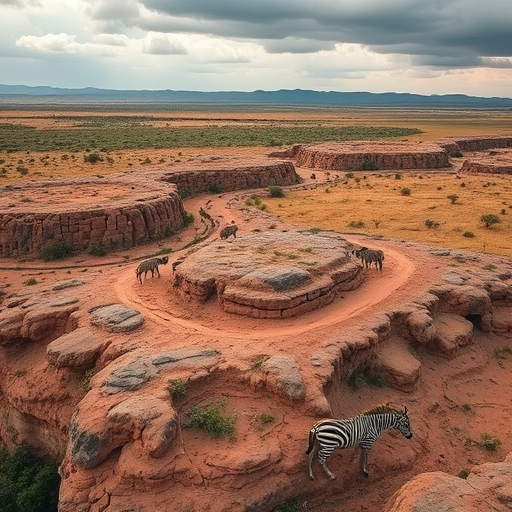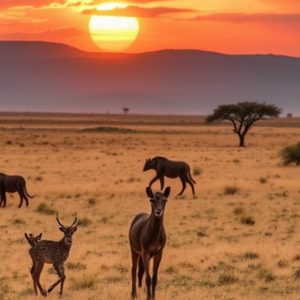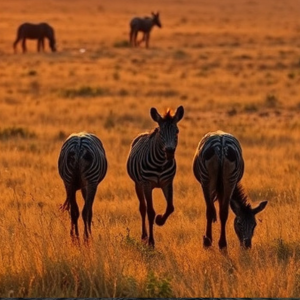Visiting Masai Mara was a dream come true. From the moment I arrived, I was captivated by the breathtaking beauty and the diversity of wildlife that the reserve has to offer. The vast savannahs, rolling hills, and wide-open plains provided a perfect backdrop for my safari adventure.
- Home
- About Us
- International
- Africa
- America
- Asia
- Australia & New Zealand
- Europe
- Middle East
AfricaEgypt
Mauritius
Zimbabve
AmericaAsiaAustralia & New ZealandEuropeCentral and Eastern Europe
Highlights
Mediterranean Europe
Middle East - Domestic
- North India
- South India
- East and North East
- Rajasthan, West and Central
North IndiaDelhi
Himachal Pradesh
Uttarakhand
Amritsar
Chandigarh
Punjab & Haryana
Uttar Pradesh
South IndiaAndaman and Nicobar Islands
Kerela
Andhra Pradesh
Tamil Nadu
East and North EastAssam
Nagaland
Tripura
Meghalaya
Rajasthan, West and Central - Temple Darshan
- Group Booking
- Blogs
- Contact Us
Sights





Explore Masai Mara
The Masai are semi-nomadic people who have lived in the region for centuries, maintaining their traditional lifestyle and customs. Their rich culture, including their language, dress, and ceremonies, is integral to the identity of Masai Mara. Visiting a Masai village offers a unique opportunity to learn about their history, social structures, and how they coexist with wildlife. These cultural experiences not only enrich your trip but also support local Masai communities through sustainable tourism initiatives.
As a visitor, it’s important to travel responsibly—respect the park’s rules, stay within designated areas, and support local businesses to contribute positively to the region’s economic development.
Places You'll See





Tour Highlights
- Well planned Tour itinerary.
- Kitchen as per our own convenience.
- Best hotels through out the tour.
- Unique tour of Scenic Beauty
- Stay in destinations that have proper facilities like hospitals, Market.
- Our groups are scheduled back to back, which is very helpful.
Tour Itinerary
Masai Mara
Days Plan
Day 1: Arrival in Nairobi, Kenya
Morning:
- Depart from India, typically via a direct flight to Nairobi (Kenya's capital). The flight duration is approximately 7 to 8 hours.
- Arrive at Nairobi Jomo Kenyatta International Airport.
Afternoon:
- Clear customs and immigration, then transfer to a hotel in Nairobi for some rest.
- You may want to opt for a day tour of Nairobi, such as visiting:
- David Sheldrick Elephant Orphanage (you can see and learn about the rescue efforts for elephants).
- Giraffe Centre to see endangered Rothschild giraffes.
Evening:
- Dinner at a local restaurant or hotel, preparing for the journey to Maasai Mara the next morning.
Day 2: Nairobi to Maasai Mara (Travel and Evening Safari)
Morning:
- Early breakfast, followed by a transfer to Wilson Airport in Nairobi for a short domestic flight to Maasai Mara (flight takes around 45 minutes).
- Alternatively, you can opt for a road trip to Maasai Mara (around 6-7 hours by car).
Afternoon:
- Upon arrival at your lodge or camp, check-in and enjoy lunch.
- Relax and prepare for an afternoon safari.
Evening:
- Go on an evening game drive to spot wildlife as they become more active in the cooler hours.
- Return to your lodge/camp for dinner.
Day 3: Full Day Safari in Maasai Mara
Early Morning:
- Wake up early for a morning game drive (around 6:00 AM). This is the best time to see predators like lions and cheetahs hunting.
Late Morning:
- Return to the lodge for a hearty breakfast.
- Relax at the lodge or enjoy the view from a viewing deck.
Afternoon:
- Enjoy lunch at the lodge.
- After lunch, take a cultural visit to a nearby Maasai village, where you’ll learn about the traditions, customs, and lifestyle of the Maasai people.
Evening:
- Embark on another evening game drive to catch sight of different animals, including elephants, buffaloes, and giraffes.
- Return to the lodge for a delicious dinner and a relaxing evening.
Day 4: Morning Safari and Scenic Experience
Early Morning:
- After an early breakfast, embark on a morning safari to explore the Mara’s vast plains.
Late Morning:
- After the safari, return to the lodge for a break.
- Consider booking an optional hot air balloon safari, which provides a stunning bird's-eye view of the Mara, especially during sunrise. It’s a unique and unforgettable experience (usually followed by a champagne breakfast).
Afternoon:
- Enjoy lunch and some leisure time to relax at the lodge.
Evening:
- If interested, take another evening game drive or a bush walk with a guide to spot smaller wildlife and learn about the ecosystem.
Day 5: Return to Nairobi and Departure
- Morning:
- After breakfast, take a final morning game drive to soak in the last views of the Mara.
- Late Morning:
- Return to the lodge, check out, and transfer back to Mara Serena Airstrip for your flight back to Nairobi.
- Afternoon:
- Arrive in Nairobi and have a late lunch (or early dinner) at a local restaurant.
- If your flight is in the evening, head to Nairobi’s international airport for your return flight to India.
Notes:
• 2 passport size photos
• Adult – Original + photocopy of any of the ID proof i.e. Aadhar Card / Driving Licence / Voters ID / Passport
• Child – Original + photocopy of any of the ID proof i.e. Aadhar Card / School ID / Passport
• Infant – Aadhar Card / Birth certificate
• NRI / Foreign nationals – Mandatory Passport + Valid Indian visa / OCI card / PIO card
• Above mentioned ID proof is mandatory at the time of booking and carry the same ID proof on tour as well
Masai Mara
Tour Details
Hear from Our
Happy Travelers

Beyond the wildlife, the Masai culture truly enriched my visit. Spending time with the Masai people, learning about their ancient traditions, and being welcomed into their communities gave me a deep appreciation for their way of life and their strong connection to the land. The Maasai’s hospitality was heartwarming,

The Masai Mara’s importance to the ecosystem is evident. Its role in preserving the biodiversity of the Mara-Serengeti ecosystem is crucial, and I was pleased to see that efforts to balance conservation and sustainable tourism are being actively pursued. It’s clear that the future of this extraordinary place

Best Time to Visit:
- The best time to visit the Masai Mara depends on what you’re hoping to experience. However, the most popular time is during the Great MigrationPeak Migration: The Great Migration typically takes place between July and October, when millions of wildebeest, zebras, and gazelles move from the Serengeti in Tanzania to the Masai Mara in Kenya..
How to Reach:
- By Air:
From Nairobi to Masai Mara by Air
- Duration: ~45 minutes to 1 hour.
- Airlines: Several airlines operate daily flights to Masai Mara, including:
- Mara Sky
- Safari Link
- Air Kenya
- Departure Points: Flights typically depart from Wilson Airport in Nairobi (not Jomo Kenyatta International Airport).
- Arrival: Flights land at various airstrips in or around the Masai Mara, such as:
- Olkiombo Airstrip
- Sekenani Airstrip
- Advantages: Fast and efficient, perfect if you want to avoid long road journeys and maximize your safari time.
- Cost: Flights can be pricey (around $150–$300 USD one-way), but they save time.
- By Train:
From Nairobi to Narok by Train (Then Road to Masai Mara)
- Duration: The train from Nairobi to Narok takes around 4–5 hours.
- Cost: The train is inexpensive (around $5–$10 USD).
- From Narok: After reaching Narok, you’ll need to take a shared vehicle or private car to Masai Mara, which takes about 1–1.5 hours.
From Nairobi to Masai Mara by Car
- Duration: ~5–6 hours depending on road conditions and the specific entry gate you use (e.g., Sekenani, Oloololo).
- Route:
- The drive from Nairobi to Masai Mara is via the Nairobi-Narok highway, then connecting to dirt roads leading to the reserve.
- The final stretch involves driving through scenic landscapes of the Great Rift Valley and Maasai villages.
- Transport Options:
- Private Car/Taxi: You can book a private vehicle for more comfort and flexibility.
- Tour Operator Transfers: Many tour operators offer all-inclusive packages with transport from Nairobi to Masai Mara.
- Self-Drive: If you’re comfortable with long drives and navigating rural roads, self-driving is an option. However, a 4×4 vehicle is recommended due to the rough roads.
Importance of Masai Mara:
- Home to the Big Five: Masai Mara is one of the best places to see the Big Five (lions, elephants, leopards, buffaloes, and rhinoceroses) in their natural habitat. It plays a key role in the conservation of these species.
- The Great Migration: The Mara is globally renowned for being the destination of the Great Migration, where millions of wildebeest, zebras, and gazelles make their annual trek from the Serengeti (Tanzania) to the Masai Mara (Kenya). This migration is one of the most spectacular wildlife events on Earth and draws tourists from all over the world.Cultural Heritage: The Maasai people, a semi-nomadic ethnic group, have lived in the region for centuries. Their cultural heritage and traditions are deeply tied to the land and animals of the Mara. They play an integral role in the management of the land and wildlife through conservation practices and eco-tourism.

Book Now and embark on your next unforgettable adventure
With our team of seasoned travel experts and local guides, we ensure that each trip is crafted to perfection, tailored to your preferences, and filled with unforgettable memories.



